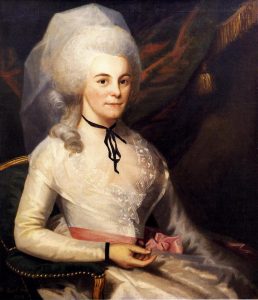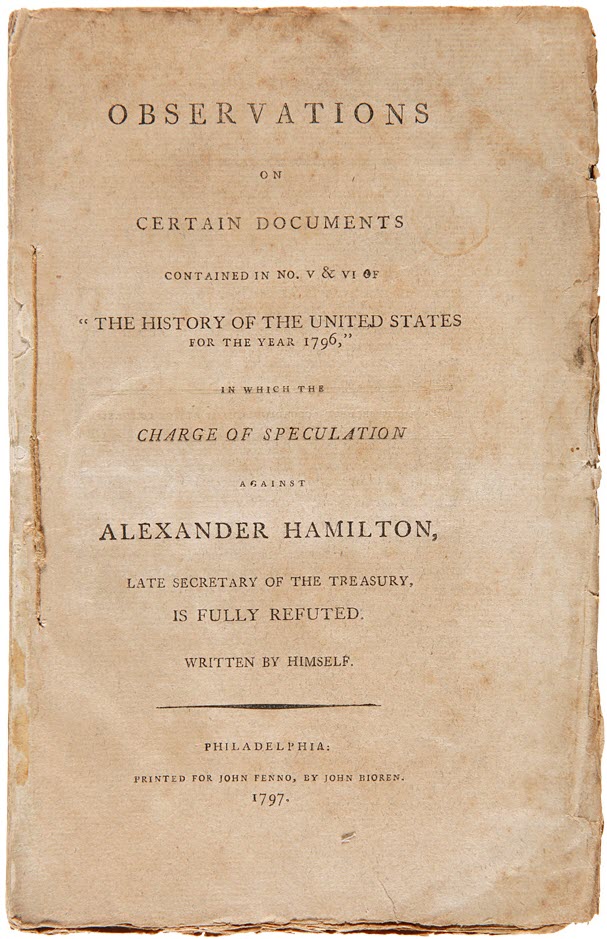In 1797, a scandal broke that would change the face of one of America’s founding fathers forever. Alexander Hamilton published a paper titled “The Reynolds Pamphlet.” It described his torrid affair with Maria Reynolds, as well as the black mail he had received from her husband. It publicly described his affair and exposed his family to scrutiny. Before the affair with Maria Reynolds, Alexander Hamilton was married to Elizabeth Schuyler, whose father was a general during the revolutionary war, a business man, and a U.S. Senator. Before they were married, Hamilton had dazzled Eliza with letters for a couple of weeks. They would end up together because of their irrevocable love, in spite of their differences: Eliza was a wealthy heiress expected to marry rich, and Hamilton was a penniless bastard orphan. Together they had eight children: Phillip, Angelica, Alexander, James Alexander, John Church, William Stephen, Eliza Hamilton Holly, and Phillip (called Little Phil in remembrance of his older brother who would later die in a duel).1 They had a happy marriage until Eliza and the children left him in New York during the summer of 1791 to go visit her father, Phillip Schuyler, in his upstate home. Hamilton did not go with his family because he was too busy working, since he was at the most important and active part in his career.2

Sometime in the summer of 1791, Hamilton was approached by Maria Reynolds while his family was away with Eliza’s father. She asked Hamilton for financial support in the form of a loan, because her husband, James Reynolds, had abandoned her for another women and left her penniless. She begged him for help; she didn’t have anywhere to go and knew of no one who could help her. She had picked Hamilton for help because he was known for his philanthropic actions. It was believed that Hamilton was willing to help because his mother had been abandoned as well and she had died because of it. When Hamilton arrived to the Reynolds house, Maria brought him inside, and then to her bedroom. They began conversing in the room and Hamilton described that she seemed to want something more than just the money.3 and thus began the Hamilton-Reynolds affair. Throughout the affair, Hamilton and Maria would pass letters back and forth to each other while meeting at the Hamilton household, the house that he shared with his wife and children.

The affair continued for the rest of that 1791 summer, and supposedly ended when his pregnant wife and children returned home from Elizabeth Schuyler-Hamilton’s father’s estate. At the same time, James Reynolds returned back home to Maria from his supposed affair. Months after the supposed end of the affair, James Reynolds found the letters that Hamilton had sent to his wife that were kept by Maria, and he wrote a furious letter to Hamilton describing his distress and anger about the situation. He claimed that Maria no longer loved him and that she only wanted Alexander. James threatened to tell Elizabeth about their affair and leave Maria penniless because of her infidelity. James Reynolds soon proposed a bribe to Hamilton. He wanted a payment of one thousand dollars, even though Hamilton’s annual salary was three thousand dollars. It seemed to Hamilton to be a nearly impossible amount. The other side of the agreement was that James would leave town and abandon Maria so that Hamilton could have her. Hamilton paid the bribe in two payments since the amount was astronomical; however, James did not leave town.4
He continued to request payments from Hamilton. They started small, at about thirty dollars; but they soon increased to nearly three hundred dollars, causing Eliza to get suspicious because they no longer had expendable income. Hamilton paid the first couple of requests, but as the amounts increased, he refused to pay and their correspondence was ended. They did not have any contact with each other up until James was arrested for the “subornation of perjury and attempting to defraud the United States” as stated by the New York court system.5 During the war and after, he had been speculating and buying up all the land with money he had printed.
While in custody, Reynolds knew he needed some sort of leverage to help earn his release, and he hinted that something nefarious was going on with the Secretary of the Treasury. Instead of defaming Hamilton’s name by speaking of the affair, Reynolds tried to encompass Hamilton in a bigger scandal, that he was using his position of power to garner financial gain.6 The people who were there to listen and to understand what Reynolds was trying to say were James Monroe, Agustus Muhlenberg, and Abraham Venable, all members of Hamilton’s opposing party, giving them a reason to listen.7 The men went to Hamilton’s office one night and threatened to go to George Washington with this information that Hamilton was misusing his power and that he was committing treason by using and stealing government money if Hamilton did not tell them everything. Hamilton explained that he believed that he had been set up by the husband-wife Reynolds team and that the payments were a result of blackmail and not speculation, and they agreed to a “gentleman’s agreement” where they would never mention it in a public setting. They found Hamilton innocent of any financial crimes, and they agreed to never use this information against him. After the men had finished discussing with Reynolds, Reynolds was released from jail. However, Hamilton would continue to receive many attacks on his character from the rumors that had begun to spread from the discussion between the four men. He would constantly have charges of corruption brought against him from the opposing party and accusations of misconduct would constantly surround him after the Whiskey Rebellion, but his involvement with Reynolds and the affair was never brought up because of the standard that kept a man’s public character from his private deeds.8

However, despite the “gentleman’s agreement,” a journalist named James Callender published an article about the charges against Reynolds after Hamilton had stepped down from office, and he included Hamilton by stating that he had abused his seat of power as Secretary of the Treasury to speculate in federal securities in the last week of June 1797 and in first week of July 1797. Callender defamed Hamilton by saying that he was corrupted by Reynolds, who was no more than a pimp, and that since his personal character was tainted by his correlation with Reynolds, his public integrity was also tainted. Hamilton speculated that James Monroe had given up Hamilton’s secrets to Callender because he was recently recalled from France and from his position as minister to France, and Monroe blamed Hamilton for the recall. Hamilton confronted Monroe about this speculation and they were so furious with each other that they almost began a duel on the spot. Monroe denied having given Callender his notes.9
Instead of ignoring the bomb that was about to go off, Hamilton decided to respond in turn to the article that Callender wrote. Hamilton wrote in a ninety-five page essay the details of his affair and the blackmail involved with it. Historian Richard Brookhiser believed that Hamilton was “ruthlessly sacrificing the privacy of his family—and hers—to protect his public reputation.”10. Hamilton described that he did not abuse his place as the Treasury Secretary because he didn’t use any of the country’s money. He only used his own earnings in two different payments. He tried separating himself from his private life and his public character, describing that his personal misconduct within his family and with his wife should not discredit him as a political figure.
Elizabeth Schuyler-Hamilton never commented on the affair publicly, and she chose to support Hamilton publicly. However, Eliza did burn some of the letters that Hamilton had written to her during their courting, erasing examples of Hamilton’s goodwill from history, as a retaliation of sorts for his infidelity and proving that she wasn’t all that supportive during this time. Their reconciliation was tainted by the death of their eldest, Philip, who was killed in a duel while using Hamilton’s gun. However, they were able to work through it and stayed together and had another child, Little Phil, until Hamilton was himself shot in a duel.
Hamilton’s career was tainted by this exploit for the rest of his life. Many opposing parties used it against him in order to discredit him and his party’s actions. He would be involved in the election of 1800, where he endorsed Thomas Jefferson over Aaron Burr, which infuriated Burr. He was still a public figure with a lot of sway in politics up until he died in a duel against Aaron Burr.11
- Diana Childress, “Family Man,” Cobblestone, October 1, 2016. ↵
- Jacob Katz Cogan, “The Reynolds Affair and the Politics of Character,” Journal of the Early Republic 16, no. 3 (1996): 389, https://doi.org/10.2307/3124057. ↵
- Jacob Katz Cogan, “The Reynolds Affair and the Politics of Character,” Journal of the Early Republic 16, no. 3 (1996): 390, https://doi.org/10.2307/3124057. ↵
- Richard Brookhiser, “The Petraeus Affair Harks Back to America’s Founding Sex Scandal: In the Reynolds Affair, Alexander Hamilton Got Entangled with the Wife of a Smalltime Crook,” American History 48, no. 1 (April 1, 2013), 22. ↵
- Jacob Katz Cogan, “The Reynolds Affair and the Politics of Character,” Journal of the Early Republic 16, no. 3 (1996): 390, https://doi.org/10.2307/3124057. ↵
- Jacob Katz Cogan, “The Reynolds Affair and the Politics of Character,” Journal of the Early Republic 16, no. 3 (1996): 394, https://doi.org/10.2307/3124057. ↵
- Jacob Katz Cogan, “The Reynolds Affair and the Politics of Character,” Journal of the Early Republic 16, no. 3 (1996): 394, https://doi.org/10.2307/3124057. ↵
- Philip Marsh, “Hamilton and Monroe,” The Mississippi Valley Historical Review 34, no. 3 (1947): 460, https://doi.org/10.2307/1898101. ↵
- Philip Marsh, “Hamilton and Monroe,” The Mississippi Valley Historical Review 34, no. 3 (1947): 461, https://doi.org/10.2307/1898101. ↵
- Richard Brookhiser, “The Petraeus Affair Harks Back to America’s Founding Sex Scandal: In the Reynolds Affair, Alexander Hamilton Got Entangled with the Wife of a Smalltime Crook,” American History 48, no. 1 (April 1, 2013), 22. ↵
- Diana Childress, “Family Man,” Cobblestone, October 1, 2016. ↵




18 comments
Michaell Alonzo
Hey Courtney, congrats on being nominated for an article award. This post was so beautifully written and fascinating to read. This page has an astonishing quantity of specific information. Being unfamiliar with Alexander Hamilton, I found your post to be intriguing. Since I gained so much fresh stuff, I’m glad I read it. I really adored the pictures you chose, which perfectly complemented the narrative you were presenting. I really appreciated how well-organized you were; it made the reading interesting for me.
Mark Gallegos
First of all, good work on writing this article! This story was very interesting and well written. The only things I knew about Alexander Hamilton was stuff I learned in history class (which was mostly his achievements and his death), and through the musical (which isn’t the best source of knowledge). This article helped me understand some of the events that lead to Hamilton’s downfall, like the impossible amount of money Hamilton was being blackmailed to pay.
Kristen Leary
Alexander Hamilton seems to be a pretty popular topic in recent years, and your article is good proof as to why. Your article was very well written, and you did well to write in an interesting manner to match such an interesting topic. Congratulations on the nomination, and on a successful article. I really enjoyed reading it, and your writing style is quite engaging to a reader.
Dallasstar Johnson
Cheers on your publishing; you did an outstanding job overall! It was enjoyable to follow along with this story. I began to wonder what might happen next. The suspension is enhanced by how well-written your post is, in my opinion. Your essay is quite well-written and comprehensive. The pictures you included were a great addition to the story as well.
Guadalupe Altamira
Great article and very well written. I’ve heard of this story many times and heard from both sides of Hamilton and his wife’s side. This way you are storytelling is great and very intriguing for many readers including me. The painful news spreading about your political figure of a husband affair was probably enough to put anyone on edge but in this case, it was Elizabeth Schuyler.
Alia Hernandez Daraiseh
I am so very proud of you Courtney for completing this article, it was very well written and the story flowed amazingly. I can see the amount of effort and work you put into this, and it really showed. I knew some information about Hamilton, but you really emphasized some of the key points that I wasn’t aware about.
Joshua Marroquin
I would like to congratulate the author on a well written article that got published and even was nominated for a prize. I didn’t know a lot about Alxander Hamilton, which is why I choose to read this article. I am happy I read it, since I learned so much new information that might come in handy one day in the near future.
Helena Griffith
Great work! This article was pretty interesting. It’s strange how frequently Hamilton’s name appears. Given that these people had Hamilton by the throat for a while, I find this narrative to be quite intriguing. But what’s terrible is that adultery has existed for a very long time and looks to be here to stay. The information and pictures are excellent!
Derric Standifer
Thank you for publishing your essay, first of all! This piece of writing is excellent! I was intrigued when I read your post since I didn’t know much about Alexander Hamilton or the history of the Reynolds Pamphlet. After reading it, I have a somewhat better understanding of the plot than I had before. The article’s general detail is also excellent.
Franchesca Tinacba
I wanted to start off my comment with a congratulations to your publication! I have heard so much about Alexander Hamilton, but I never took time to really get to know him. I think one thing I enjoyed was how detailed and well written this article was. I truly believe that this helps to show that not all of history was glamorous as we thought it was through entertainment (the musical). Overall, awesome read and very informative!